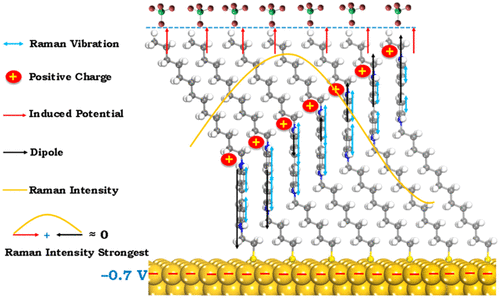当前位置:
X-MOL 学术
›
J. Am. Chem. Soc.
›
论文详情
Our official English website, www.x-mol.net, welcomes your feedback! (Note: you will need to create a separate account there.)
Probing Electric Field Distributions in the Double Layer of a Single-Crystal Electrode with Angstrom Spatial Resolution using Raman Spectroscopy
Journal of the American Chemical Society ( IF 15.0 ) Pub Date : 2020-06-17 , DOI: 10.1021/jacs.0c05162 Bao-Ying Wen 1 , Jia-Sheng Lin 1 , Yue-Jiao Zhang 1 , Petar M Radjenovic 1 , Xia-Guang Zhang 2 , Zhong-Qun Tian 1 , Jian-Feng Li 1
Journal of the American Chemical Society ( IF 15.0 ) Pub Date : 2020-06-17 , DOI: 10.1021/jacs.0c05162 Bao-Ying Wen 1 , Jia-Sheng Lin 1 , Yue-Jiao Zhang 1 , Petar M Radjenovic 1 , Xia-Guang Zhang 2 , Zhong-Qun Tian 1 , Jian-Feng Li 1
Affiliation

|
The electrical double layer (EDL) is the extremely important interfacial region involved in many electrochemical reactions, and is the subject of significant study in electrochemistry and surface science. However, the direct measurement of interfacial electric fields in the double layer is challenging. Herein, both electrochemical resonant Raman spectroscopy and theoretical calculations were used to study electric field distributions in the double layer of an atomically flat single-crystal Au(111) elec-trode with self-assembled monolayer (SAM) molecular films. This was achieved using a series of redox-active molecules con-taining the 4',4-bipyridinium moiety Raman marker located at different, precisely controlled, distances away from the electrode surface. It was found that the electric field and the dipole mo-ment of the probe molecule both directly affected its Raman signal intensity, which in turn could be used to map the electric field distribution at the interface. Also, by varying the electrolyte anion concentration, the Raman intensity was found to decrease when the electric field strength increased. Moreover, the distance between adjacent Raman markers was ~2.1 Å. Thus, Angstrom-level spatial resolution in the mapping of electric field distribu-tions at the electrode-electrolyte interface was realized. These results directly evidence the electrical double layer structure, bridging the gap between the theoretical and experimental under-standings of the interface.
中文翻译:

使用拉曼光谱以埃空间分辨率探测单晶电极双层中的电场分布
双电层(EDL)是涉及许多电化学反应的极其重要的界面区域,是电化学和表面科学领域的重要研究课题。然而,直接测量双层中的界面电场具有挑战性。在此,电化学共振拉曼光谱和理论计算均用于研究具有自组装单层 (SAM) 分子膜的原子平面单晶 Au(111) 电极的双层中的电场分布。这是使用一系列氧化还原活性分子实现的,这些分子包含 4',4-bipyridinium 部分拉曼标记,位于距电极表面不同的、精确控制的距离处。发现探针分子的电场和偶极矩均直接影响其拉曼信号强度,进而可用于绘制界面处的电场分布。此外,通过改变电解质阴离子浓度,发现当电场强度增加时拉曼强度降低。此外,相邻拉曼标记之间的距离为~2.1 Å。因此,在电极-电解质界面处的电场分布映射中实现了埃级空间分辨率。这些结果直接证明了双电层结构,弥合了界面的理论和实验理解之间的差距。此外,通过改变电解质阴离子浓度,发现当电场强度增加时拉曼强度降低。此外,相邻拉曼标记之间的距离为~2.1 Å。因此,在电极-电解质界面处的电场分布映射中实现了埃级空间分辨率。这些结果直接证明了双电层结构,弥合了界面的理论和实验理解之间的差距。此外,通过改变电解质阴离子浓度,发现当电场强度增加时拉曼强度降低。此外,相邻拉曼标记之间的距离为~2.1 Å。因此,在电极-电解质界面处的电场分布映射中实现了埃级空间分辨率。这些结果直接证明了双电层结构,弥合了界面的理论和实验理解之间的差距。
更新日期:2020-06-17
中文翻译:

使用拉曼光谱以埃空间分辨率探测单晶电极双层中的电场分布
双电层(EDL)是涉及许多电化学反应的极其重要的界面区域,是电化学和表面科学领域的重要研究课题。然而,直接测量双层中的界面电场具有挑战性。在此,电化学共振拉曼光谱和理论计算均用于研究具有自组装单层 (SAM) 分子膜的原子平面单晶 Au(111) 电极的双层中的电场分布。这是使用一系列氧化还原活性分子实现的,这些分子包含 4',4-bipyridinium 部分拉曼标记,位于距电极表面不同的、精确控制的距离处。发现探针分子的电场和偶极矩均直接影响其拉曼信号强度,进而可用于绘制界面处的电场分布。此外,通过改变电解质阴离子浓度,发现当电场强度增加时拉曼强度降低。此外,相邻拉曼标记之间的距离为~2.1 Å。因此,在电极-电解质界面处的电场分布映射中实现了埃级空间分辨率。这些结果直接证明了双电层结构,弥合了界面的理论和实验理解之间的差距。此外,通过改变电解质阴离子浓度,发现当电场强度增加时拉曼强度降低。此外,相邻拉曼标记之间的距离为~2.1 Å。因此,在电极-电解质界面处的电场分布映射中实现了埃级空间分辨率。这些结果直接证明了双电层结构,弥合了界面的理论和实验理解之间的差距。此外,通过改变电解质阴离子浓度,发现当电场强度增加时拉曼强度降低。此外,相邻拉曼标记之间的距离为~2.1 Å。因此,在电极-电解质界面处的电场分布映射中实现了埃级空间分辨率。这些结果直接证明了双电层结构,弥合了界面的理论和实验理解之间的差距。



























 京公网安备 11010802027423号
京公网安备 11010802027423号